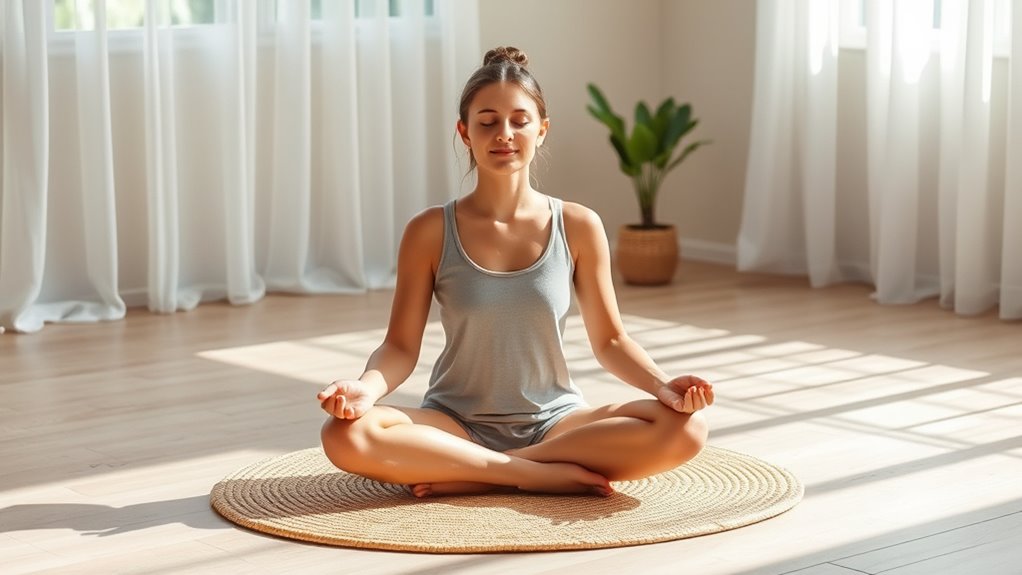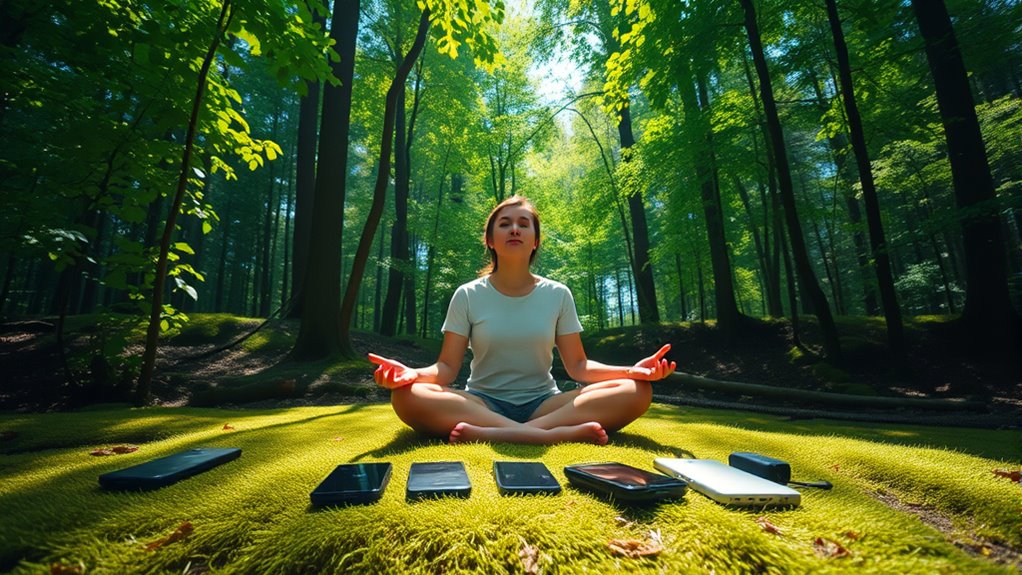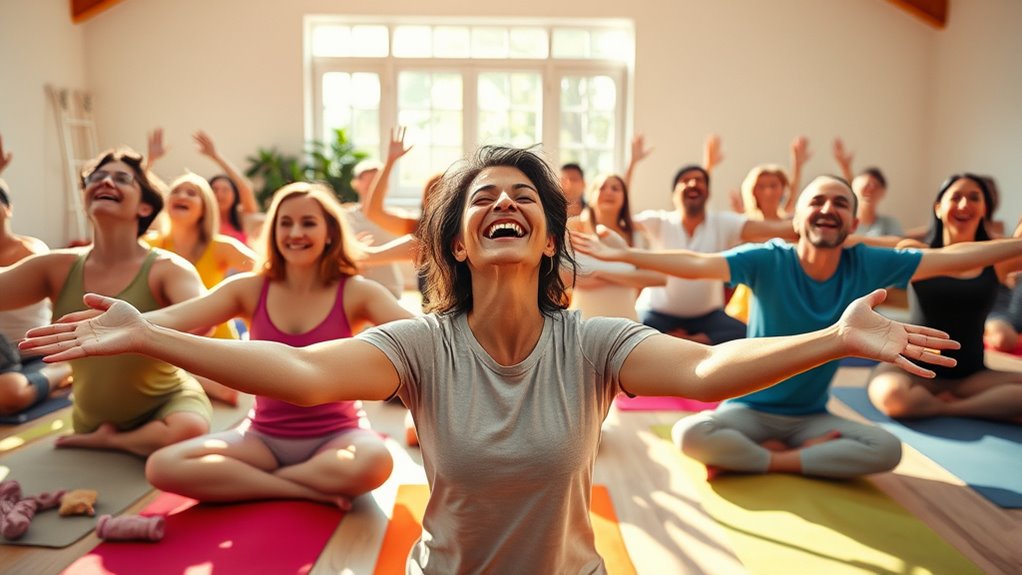Mindfulness & Well‑Being
Body Scan Meditation: A Script for Beginners
The transformative power of body scan meditation can enhance relaxation and awareness; discover how to begin with our beginner-friendly script.

To start a body scan meditation, find a quiet space and get comfortable. Close your eyes if you prefer, take deep breaths, and turn your focus to the top of your head. Slowly move downward, observing sensations in each body part without judgment. Notice tension, warmth, or coolness, and gently shift attention as you scan your shoulders, arms, legs, and feet. Keep practicing regularly, and you’ll discover simple ways to deepen your relaxation and awareness. If you continue exploring, you’ll find step-by-step guidance for beginners.
Key Takeaways
- Provides a step-by-step guide to perform body scan meditation tailored for beginners.
- Emphasizes mindful observation of sensations without judgment during each body part scan.
- Includes simple instructions for preparation, breathing, and gradually focusing from head to toes.
- Offers a structured script to facilitate relaxation, awareness, and stress reduction.
- Highlights the benefits of regular practice to improve mindfulness and overall well-being.

Have you ever wondered how to deepen your awareness of your body and promote relaxation? If so, practicing a body scan meditation can be a powerful tool. This simple yet effective mindfulness practice encourages you to connect with each part of your body, helping you release tension and foster a sense of calm. Many beginners find that incorporating body scan meditation into their routine enhances their overall relaxation techniques, making it easier to manage stress and stay present.
Start by finding a quiet, comfortable space where you won’t be disturbed. Sit or lie down in a relaxed position, closing your eyes if you feel comfortable doing so. Take a few deep breaths, inhaling slowly through your nose and exhaling through your mouth. Let your body settle into its natural rhythm. As you begin, remind yourself that this practice is about observing sensations without judgment. Your goal isn’t to change how you feel but simply to notice what’s happening in your body right now.
Find a quiet, comfortable space, relax, breathe deeply, and observe your sensations without judgment.
Begin your mindfulness practice at the top of your head. Bring your attention to your scalp, noticing any sensations or tension. Don’t try to change anything; just observe. Slowly move your focus downward to your forehead, your eyes, your cheeks, and your jaw. Pay attention to how each area feels—whether it’s relaxed, tense, warm, or cool. As you move down your neck and shoulders, see if you can identify any tightness or discomfort. Imagine releasing tension with each exhale, letting your shoulders drop and soften.
Continue this process down your arms, your hands, and fingers, feeling each part as you go. Notice if your hands are clenched or open, warm or cold. When you reach your chest and abdomen, observe the rise and fall of your breathing. Feel your belly expand with each inhale and soften on the exhale. Moving further down, scan through your hips, pelvis, and legs. Pay attention to how your legs feel against the surface beneath you, whether they’re heavy or light. Incorporating awareness of muscle tension can further deepen your relaxation.
Finally, bring awareness to your feet and toes. Notice any sensations, such as tingling or warmth. As you complete the body scan, take a few more deep breaths. Gently bring your attention back to the room, opening your eyes when you’re ready. Practicing this regularly can become a cornerstone of your relaxation techniques, helping you cultivate a greater sense of calm and presence. It’s a simple yet powerful way to connect with your body and nurture your overall well-being.
Frequently Asked Questions
How Long Should a Beginner’s Body Scan Meditation Last?
For a beginner, the ideal meditation duration is about 10 to 15 minutes. Starting with a shorter session helps you build consistency and comfort without feeling overwhelmed. As you become more experienced, you can gradually extend your session length. Focus on maintaining a steady, mindful pace during your body scan, ensuring you stay present and relaxed throughout the meditation duration.
Can Body Scan Meditation Improve Sleep Quality?
Imagine waking up feeling like a brand-new person every morning—that’s what sleep enhancement through relaxation techniques can do. Body scan meditation helps you relax deeply, easing your mind and body into restful sleep. Regular practice reduces stress and calms racing thoughts, making it easier to drift off. Incorporate this simple technique into your nightly routine, and you’ll unleash the power of quality sleep and total relaxation.
Is Body Scan Meditation Suitable for Children?
You might wonder if body scan meditation suits children. While it promotes mindfulness, you should adapt it for kids by keeping sessions short and engaging. Incorporate child mindfulness techniques into family activities to help them develop awareness and calmness. Active participation benefits both you and your child, making it a helpful tool for relaxation and focus. Just guarantee the practice feels fun and accessible for young minds.
What Should I Do if I Feel Discomfort During the Scan?
Think of discomfort during a body scan like a passing cloud—you acknowledge it and let it drift away. If you feel discomfort, gently pause, breathe deeply, and use mindfulness techniques to manage it. Focus on your breath or a calming word, rather than forcing yourself through pain. Remember, discomfort management is part of mindfulness, helping you stay present and gentle with yourself during the scan.
How Often Should I Practice Body Scan Meditation for Best Results?
You should aim for a regular meditation frequency, ideally practicing body scan meditation daily or at least several times a week. Consistency tips include setting a specific time and creating a calming environment. Regular practice helps you deepen relaxation, increase mindfulness, and notice subtle bodily sensations. Over time, this consistency can lead to better stress management and enhanced overall well-being, making your meditation routine more effective and rewarding.
Conclusion
As you gently drift back from this journey through your body, imagine yourself as a calm lake, its surface smooth and clear. With each breath, you’ve peeled back the layers of tension, revealing your true, peaceful self beneath. Remember, this meditation is a gentle anchor you can return to anytime storms arise. Like a lighthouse guiding ships home, your body scan guides you back to serenity, one mindful step at a time.
Mindfulness & Well‑Being
Digital Detox for Mental Clarity: How to Reset Your Brain
Just unplugging from screens can refresh your mind, but discovering the full benefits of a digital detox will surprise you.

To reset your brain and boost mental clarity, start by reducing digital overload—turn off notifications and limit screen time, especially before bed. Practice mindfulness through meditation or deep breathing to quiet mental chatter. Create a tech-free sleep environment by removing screens and establishing relaxing routines. Combining these habits helps your brain rest and reset, improving focus and emotional balance. Keep exploring ways to enhance your mental well-being and discover more effective strategies.
Key Takeaways
- Practice intentional digital breaks and limit screen time to reduce mental overload and foster present-moment awareness.
- Incorporate mindfulness techniques like breathing exercises or mindful walks to calm mental chatter and enhance clarity.
- Establish a digital curfew and create a relaxing bedtime routine to improve sleep quality and support brain reset.
- Optimize your sleep environment by removing screens, using blackout curtains, and maintaining a cool, quiet space.
- Combine mindfulness with good sleep hygiene to build resilience against digital stress and promote sustained mental clarity.

In today’s hyperconnected world, constant notifications and endless scrolling can cloud your mind and drain your energy. You might find yourself feeling overwhelmed, distracted, or just mentally exhausted, even after hours of screen time. To counter this, embracing mindfulness practices can make a significant difference. When you intentionally pause and focus on the present moment, you effectively quiet the mental chatter that digital overload often amplifies. Simple breathing exercises, meditation, or mindful walking help you reconnect with your senses and reduce stress. These practices train your brain to be more aware of when it’s overwhelmed, creating space for clarity and calm. Incorporating mindfulness into your daily routine also encourages healthier habits around your screens, making you more conscious of when you need a break. Additionally, choosing the right tools, like paint sprayer accessories, can streamline your projects and reduce digital distractions by minimizing trial-and-error during work.
Pause, breathe, and focus on the present to clear digital overload and restore mental calm.
Beyond mindfulness, improving your sleep hygiene is vital for resetting your brain. The constant barrage of digital stimuli can interfere with your ability to fall asleep and enjoy restorative rest. Blue light emitted from screens suppresses melatonin production, the hormone responsible for regulating your sleep cycle. To promote better sleep hygiene, establish a digital curfew—turn off screens at least an hour before bed. Instead, opt for relaxing activities like reading a physical book, journaling, or gentle stretches. Creating a calming bedtime routine signals to your brain that it’s time to wind down, making it easier to transition into restful sleep. When you prioritize quality sleep, your brain can process information more efficiently, improve memory, and reset your mental state, which ultimately enhances your overall mental clarity.
You’ll also want to pay attention to your environment. Keep your bedroom a screen-free zone to avoid temptation and guarantee your sleep space promotes relaxation. Use blackout curtains and maintain a cool, quiet atmosphere to support uninterrupted sleep cycles. When you wake up refreshed, your mental clarity increases, and you’re better prepared to handle daily stressors without feeling overwhelmed by digital distractions.
Combining mindfulness practices with good sleep hygiene creates a powerful foundation for mental clarity. By intentionally disconnecting, you give your brain the chance to rest and reset. Over time, you’ll notice yourself becoming less reactive to digital chaos and more centered in the present moment. These habits don’t just improve your mental state—they enhance your overall well-being, helping you regain control over your focus, energy, and peace of mind. Taking these steps can transform how you engage with technology, turning your digital experiences into tools that support rather than hinder your mental health.
Frequently Asked Questions
How Long Should a Digital Detox Last for Optimal Mental Clarity?
A digital detox should last at least 24 to 48 hours to effectively reset your mental clarity. During this unplugging duration, avoid screen time entirely, allowing your mind to unwind and regain focus. If you can extend it to a weekend or longer, you’ll notice even greater benefits. Shorter breaks help, but sustained unplugging fosters better mental reset, reducing stress and improving overall well-being.
Can Digital Detoxing Improve Sleep Quality Significantly?
Imagine reducing your screen time an hour before bed; many find their sleep improves markedly. Digital detoxing can boost sleep quality by minimizing blue light exposure, which disrupts melatonin production. When you cut back on screen time, your sleep habits become healthier, allowing you to fall asleep faster and enjoy deeper rest. So yes, a digital detox can substantially enhance your sleep quality and overall well-being.
Are There Specific Apps to Help Monitor Digital Usage?
Yes, there are specific apps to help monitor your digital usage. Apps like Screen Time, Moment, and Digital Wellbeing track your screen time and app activity, giving you insights into your habits. You can also use app blockers like Freedom or StayFocusd to limit distractions. These tools empower you to set boundaries, reduce overuse, and maintain a healthier digital balance, ultimately supporting your mental clarity.
What Are the Common Challenges Faced During a Digital Detox?
During a digital detox, you’ll likely face challenges like screen addiction and social media fatigue. You might struggle with urges to check your devices, feeling anxious or restless without constant connectivity. It’s common to experience boredom or frustration as your brain adjusts. Staying committed can be tough, but setting clear goals, replacing screen time with enjoyable activities, and practicing mindfulness help you overcome these hurdles and reset your mental clarity.
How Can I Reintroduce Technology Healthily After Detoxing?
So, you’ve survived your digital detox—congratulations! Now, to reintroduce technology healthily, set clear tech boundaries and practice mindful reintroduction. Limit your screen time, prioritize meaningful interactions, and avoid mindless scrolling. Keep a routine that balances online and offline life, and check in with yourself regularly. This way, you’ll enjoy tech’s benefits without falling back into chaos, all while maintaining your mental clarity and peace.
Conclusion
Imagine your mind as a clear lake, free from ripples and distractions. By unplugging and stepping away from screens, you let your mental waters settle, revealing calm and clarity beneath. Embrace this digital detox, and watch your thoughts become sharper, your mood lighter. With each moment of disconnect, you’re carving out space for peace and focus. Reset your brain like a fresh dawn—bright, open, and ready for new ideas to bloom.
Mindfulness & Well‑Being
Guided Imagery Scripts for Stress Relief
Feeling overwhelmed? Discover how guided imagery scripts can help you relax and find peace in moments of stress.

Guided imagery scripts for stress relief help you relax by guiding you through calming mental scenes, combined with deep breathing and muscle relaxation. You’ll visualize peaceful places like beaches or forests, focusing on sensory details to quiet your mind. Incorporating slow breath patterns deepens your relaxation and reinforces the calming effects. Consistent practice trains your body and mind to respond quickly to stress, making relaxation accessible whenever you need it. Keep exploring to discover more effective techniques for stress relief.
Key Takeaways
- Guided imagery scripts typically involve calming mental scenes like beaches, forests, or streams to promote relaxation.
- Incorporate deep breathing techniques within scripts to deepen stress relief and sensory engagement.
- Use progressive muscle relaxation cues alongside visualization to release physical tension effectively.
- Scripts should be practiced regularly to train the mind and body for quick stress response.
- Combining visualization with breathing and muscle relaxation enhances overall emotional well-being and calmness.

Guided imagery scripts are a powerful tool for reducing stress and promoting relaxation. When you use these scripts, you’re guided through calming mental pictures that help quiet your mind and ease tension in your body. One of the most effective ways to deepen your relaxation is by combining guided imagery with relaxation techniques like deep breathing. As you listen or read through a script, focus on taking slow, deliberate breaths, inhaling deeply through your nose and exhaling fully through your mouth. This deep breathing helps oxygenate your body, slow your heart rate, and foster a sense of calm. It’s a simple yet powerful method to anchor your mind during the visualization process, making it easier to let go of stress and intrusive thoughts.
Using guided imagery along with relaxation techniques allows you to create a peaceful mental space that feels safe and soothing. As you follow the script, you might imagine yourself walking through a quiet forest, sitting beside a gentle stream, or lying on a warm beach. Visualizing these scenarios becomes more vivid when combined with deep breathing, which enhances the sensory experience. For example, as you picture yourself sitting on a soft blanket under the shade of trees, take a slow, deep breath to match the tranquility of the scene. With each exhale, release any tension you’re holding onto. This deliberate breathing pattern not only deepens your sense of relaxation but also helps to reset your nervous system from stress mode to calm.
Incorporating relaxation techniques into guided imagery also involves consciously relaxing different muscle groups. As you listen to or read the script, you might be prompted to tense and then release your muscles, starting from your toes and working up to your shoulders. When combined with mindful deep breathing, this progressive muscle relaxation amplifies the calming effect. It’s a way to signal to your body that it’s safe to unwind, making it easier to let go of worries and physical tension. Over time, practicing these techniques together can help you develop a natural response to stress, where deep breathing and visualization become your go-to tools for instant relief.
Ultimately, the key to benefiting from guided imagery scripts is consistency. When you regularly practice these relaxation techniques alongside vivid visualization, you train your mind and body to respond quickly and effectively to stress. Whether you’re dealing with daily pressures or more intense anxiety, integrating deep breathing and relaxation strategies into guided imagery can transform your stress management routine, helping you find calm and clarity whenever you need it.
Frequently Asked Questions
Can Guided Imagery Replace Therapy for Stress Management?
You might wonder if guided imagery can replace therapy for stress management. While it strengthens your mind-body connection and improves emotional regulation, it’s often a complementary tool rather than a complete substitute. Guided imagery helps you relax and gain insight, but therapy provides personalized strategies and support for deeper issues. Combining both offers a balanced approach, empowering you to manage stress effectively and build lasting resilience.
How Often Should I Practice Guided Imagery for Best Results?
You might find it surprising, but consistent practice really boosts results. To get the most from guided imagery, aim for daily sessions, about 10-15 minutes each. This practice frequency helps reinforce relaxation, while an ideal duration ensures you stay engaged without feeling overwhelmed. Stick with this routine, and you’ll likely notice stress reducing more effectively over time, turning calming imagery into a natural part of your self-care.
Are There Any Risks or Contraindications With Guided Imagery?
You might wonder if guided imagery has risks. Generally, it’s safe, but be aware of physical risks if you have health issues that could be affected by relaxation or visualization. Emotional triggers could also arise if certain images evoke strong feelings or memories. If you notice distress, stop and consult a healthcare professional. Always approach guided imagery gently, especially if you’re prone to emotional sensitivities or physical concerns.
Can Children or Seniors Effectively Use Guided Imagery Scripts?
You might wonder if children or seniors can benefit from guided imagery scripts. Research shows that child-friendly techniques and senior relaxation methods are effective, as they adapt to different cognitive levels and needs. Children often respond well to simple, playful scripts, while seniors find visualization calming and accessible. With proper guidance, both groups can use guided imagery to reduce stress, improve mood, and enhance overall well-being.
How Do I Create Personalized Guided Imagery Scripts?
To create personalized guided imagery scripts, start by identifying your favorite relaxation imagery themes, like peaceful beaches or calming forests. Use personalization techniques such as including specific sensory details and personal preferences to make the script resonate deeply. Focus on vivid, descriptive language that engages your senses. This way, your script feels uniquely tailored, helping you relax more effectively as you visualize these calming scenes.
Conclusion
As you embrace these guided imagery scripts, remember that you’re wielding a powerful tool akin to Icarus’s wings—capable of lifting you above stress if used wisely. With each breath, you forge a path toward serenity, much like the steady river carving its course through the landscape. Trust in this journey, knowing that, like the phoenix rising from ashes, you can renew your calm and resilience whenever life’s pressures threaten to overwhelm you.
Mindfulness & Well‑Being
The Science of Laughter Yoga and Everyday Joy

Laughter yoga combines intentional laughter with deep breathing exercises, offering real mental, physical, and emotional health benefits. It boosts your mood by releasing feel-good chemicals like endorphins and relaxes your body, reducing stress hormones. The practice also improves circulation, strengthens muscles, and promotes better sleep. By regularly practicing laughter yoga, you can build resilience and find joy in everyday life. If you’re curious, exploring how this simple activity impacts your well-being can be quite revealing.
Key Takeaways
- Laughter yoga combines intentional laughter with deep breathing, triggering neurochemical releases that boost mood and reduce stress.
- It enhances physiological health by increasing oxygen intake, lowering blood pressure, and strengthening immune function.
- Regular practice fosters social bonds and shared joy, promoting emotional resilience and combating loneliness.
- The practice activates muscles and stimulates blood flow, contributing to physical vitality and cardiovascular health.
- Overall, laughter yoga creates a holistic sense of well-being by integrating mental uplift with physical relaxation and energy.

Laughter yoga combines intentional laughter with deep breathing exercises to promote physical and mental well-being. When you engage in laughter yoga, you’re not just making funny faces or giggling aimlessly—you’re actively triggering a range of psychological benefits and physiological responses that can enhance your overall health. The combination of laughter and controlled breathing stimulates your nervous system, leading to a cascade of positive effects. As you laugh, your brain releases feel-good chemicals like endorphins, which lift your mood and reduce stress. This mental shift can help you feel more relaxed, confident, and resilient in everyday situations.
Laughter yoga boosts mental and physical health through intentional laughter and deep breathing.
One of the key psychological benefits of laughter yoga is its ability to diminish feelings of anxiety and depression. When you laugh intentionally, you break the cycle of negative thoughts that often plague your mind. It’s like a reset button for your mental state, making it easier to approach challenges with a more optimistic outlook. Plus, laughter fosters social connection, which is essential for emotional health. When you participate in group laughter sessions, you experience a sense of community and shared joy, strengthening your social bonds and reducing feelings of loneliness or isolation. Engaging in protective styling benefits through activities like laughter yoga also encourages a holistic approach to health and wellness.
On the physiological level, laughter yoga prompts your body to respond in ways that boost your physical health. Deep breathing exercises involved in the practice increase oxygen intake, improving circulation and energizing your tissues. This physiological response can lower blood pressure and enhance your immune function, making you more resilient to illnesses. The rhythmic breathing also helps relax your muscles and calms your nervous system, reducing stress hormones like cortisol. Over time, these responses contribute to better cardiovascular health and improved sleep patterns.
Furthermore, the act of laughing itself is a physical activity that engages your core muscles, facial muscles, and even your diaphragm. This not only boosts muscular tone but also stimulates the release of nitric oxide, which helps relax blood vessels and promote healthy blood flow. Many practitioners report feeling more energized and less fatigued after laughter yoga sessions. The combination of mental uplift and physical stimulation creates a holistic sense of well-being, making it easier for you to handle daily stresses with a positive attitude.
In essence, laughter yoga’s intentional practice taps into your body’s natural ability to heal and rejuvenate. By consciously engaging in this joyful activity, you’re harnessing the power of psychological benefits and physiological responses that can transform your outlook and overall health. It’s a simple, accessible way to infuse more joy into your life, fostering resilience and vitality in both body and mind.
Frequently Asked Questions
Can Laughter Yoga Be Effective if I Don’t Naturally Laugh Easily?
If you don’t laugh easily, laughter yoga can still be effective. It encourages you to focus on laughter authenticity rather than genuine humor, helping you relax and open up. Social influence plays a big role, so participating with others can make it easier to engage. Over time, even forced laughter can boost your mood and create genuine joy, proving that laughter yoga benefits everyone, regardless of natural laughter tendencies.
How Long Does It Take to See Benefits From Regular Laughter Yoga Practice?
Think of laughter yoga as planting seeds of joy; with time, blooms appear. Your timing expectations depend on consistency and your unique body’s response. Some notice mood lifts within a few sessions, while others see progress indicators like reduced stress or better sleep after several weeks. Keep practicing, and you’ll find the rhythm that unlocks your laughter’s healing potential. Patience turns your efforts into a garden of daily happiness.
Are There Any Risks or Contraindications for Laughter Yoga Participants?
You might wonder about laughter safety and potential contraindications risks when practicing laughter yoga. Generally, it’s safe for most people, but if you have respiratory issues, heart problems, or are pregnant, you should consult your doctor first. Avoid intense laughter exercises if you feel dizzy or uncomfortable. Being aware of these contraindications risks helps make certain you enjoy the benefits of laughter yoga safely and comfortably.
Does Laughter Yoga Work Equally Well for All Age Groups?
You might think laughter yoga isn’t suitable for all ages, but it actually offers age-specific benefits and adapts well across ages. Whether you’re young or senior, you can find tailored exercises that suit your needs, promoting relaxation, social connection, and stress relief. Its flexibility guarantees everyone can participate comfortably, making it an inclusive practice that enhances well-being regardless of age.
How Does Laughter Physiologically Impact Stress Levels and Immune Function?
Laughter impacts your physiology by triggering an endocrine response that releases feel-good hormones like endorphins. It activates neural pathways in your brain, reducing stress hormones like cortisol. This combination boosts your immune function, making you less susceptible to illness. When you laugh, you enhance your body’s ability to manage stress, leading to improved overall health and resilience. So, laughter isn’t just fun—it’s a powerful health tool.
Conclusion
So, by embracing laughter yoga, you’re revealing the secret to turning every dull moment into a nonstop comedy show! Imagine laughing so hard that your happiness skyrockets to the moon and back, making stress vanish faster than you can say “giggle attack.” With just a little practice, you’ll wield the power to turn the ordinary into extraordinary, transforming your daily life into a never-ending carnival of joy. Get ready—laughter truly is the world’s most magical medicine!
-

 Wish Notes1 year ago
Wish Notes1 year agoBest Caption to Wish Myself a Happy Birthday That Everyone Will Like!
-

 Wish Notes1 year ago
Wish Notes1 year agoThe Best Birthday Wishes to Make Your Uncle's Day Bright!
-

 Wish Notes1 year ago
Wish Notes1 year agoThe Sweetest Happy Birthday Wishes for Your Wife!
-

 Wish Notes1 year ago
Wish Notes1 year agoThe Best Happy Birthday Wish for Your Brother That Will Make Him Smile!
-

 Wish Notes1 year ago
Wish Notes1 year agoHeartwarming Birthday Messages for Mom in Spanish
-

 Wish Notes1 year ago
Wish Notes1 year agoThe Best Happy Birthday Wishes for Your Husband That Will Make His Day!
-

 Wish Notes1 year ago
Wish Notes1 year agoThe Ultimate Birthday Wishes to Celebrate Yourself!
-

 Wish Notes1 year ago
Wish Notes1 year agoThe Most Heartfelt Good Night Wishes Ever!





















